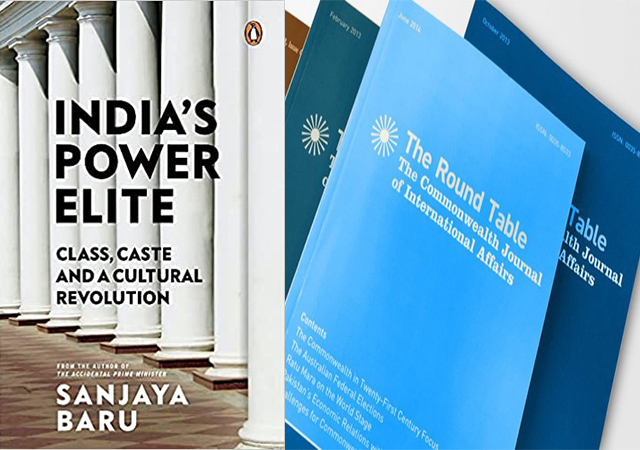
[This is an excerpt from a book review in The Round Table: The Commonwealth Journal of International Affairs.]
Offering a definitive analysis of how political and economic power is distributed in modern India throws challenges which are, to a large extent, sui generis. For one thing, reliable statistics about income and wealth distribution among various population groups are hard to come by; for another, Western methods of classification involving fairly distinct lines of demarcation between, say, the middle and working classes don’t necessarily lend themselves to application in India (the problem being further compounded by the presence of the vestiges of feudalism which remain quite deeply entrenched and which are widely spread). A third challenge for analysts is to grapple with the intricacies of caste, language and regional identities – as well as class – in making judgements about who constitute the ‘elite’ at any given time. And as if all of that were not intimidating enough, there is the overarching frustration which most commentators on India face, best encapsulated in the words of the late economist Joan Robinson: ‘Whatever you can rightly say about India, the opposite is also true’.
Against that setting, it is indeed brave of Sanjaya Baru, a journalist and academic with a background in economics, to embark on a topical enquiry which has led to the present book. He is at pains to dispel any assumptions that may be made about the nature of the book. It is, he insists, most certainly not an academic enterprise, but rather ‘a polemical tract, full of assertions aiming to focus on who matters and why in [Prime Minister] Modi’s New India’ (p. xv). That does not, of course, stop him from straying, for the benefit of readers, into references to power equations prevalent in the pre-Modi era, including during the ten years of Prime Minister Manmohan Singh’s time in office, for five of which Baru served as Singh’s media adviser.
Indeed, he sees the 1990s – the era which marked the advent of coalition politics under Prime Ministers Narasimha Rao and Atal Bihari Vajpayee and a full decade before even the ascension of Singh to power – as a crucial turning point in Indian politics:
From 1947 till 1989, the Nehru-Gandhi family had been at the apex of the pyramid of power in India. An entire caste of the New Delhi-based elite that constituted the ‘Delhi Darbar’ of the Nehru-Gandhi dynasty was now being forced to adjust itself to the power shift. (p. xi)
That power shift did not result in a dismantling of the Durbar but in its continuance under subsequent administrations, including Modi’s, although the personages, predictably, changed. Those belonging to this clique got a new label under Modi – ‘Lutyens’ Delhi’, referring to the fact that members of this elite live in the roughly 10 square mile leafy zone which houses spacious bungalows designed by the British architect Sir Edwin Lutyens between 1920 and 1940 for use by government ministers and senior civil servants. Modi and his supporters use that moniker in a pejorative way, but as Baru points out, that is not without irony considering that Modi himself is one of the prominent inhabitants of Lutyens’ Delhi. Moreover,
Modi wanted to be loved by the denizens of Lutyens’ Delhi, but he also loved hating them. He was willing to befriend and be interviewed by a journalist who hailed from that world, but he also disliked being questioned by those not overawed by his rise to power. Modi was not yet comfortable with becoming an insider, having been regarded as an outsider for so long. (p. xiii)
Modi also, says Baru, carries a chip on his shoulder arising from the fact that, unlike his predecessor, he has no educational credentials to flaunt (‘Singh’, on the other hand, ‘never failed to remind those who needed reminding that he had Oxbridge pedigree’ – p. xiii). A central conundrum about Modi, which Baru expounds on but superficially, is that, for all his frequent mocking of the powerful, Modi is simultaneously an inveterate seeker of power himself.
There is, explains Baru, a strong anti-elitist streak in Modi which has both class and caste dimensions (Modi was born into a lower caste family and grew up in straitened circumstances as the son of someone who sold tea on a railway platform). This was layered with Hindu nationalism imbibed from the Bharatiya Janata Party (BJP) which shaped his politics from a young age. More dramatically, Baru argues that Modi’s anti-elitism was also driven by two impulses that lay behind Mao’s Cultural Revolution: ‘a distrust of the inherited bureaucratic and intellectual elite and the urge to create a new elite in his own ideological image’ (p. 17), although the author hastens to add that Modi’s brand of anti-elitism has been less disruptive than that of the Red Guards in China. An entire chapter in the book discusses the ‘paradoxical relationship between elitism and power’ (chapt 3 – pp. 45–56).
Away from Modi, Baru also throws light on the Congress Party’s attitude to power in the decades for which it held the upper hand in Indian politics, both before and after independence from British rule. A particularly illuminating nugget included in the book is the extent to which Jawaharlal Nehru’s mother, Swarup Rani, went to ensure dynastic succession to the Congress presidency as far back as 1928. She even enlisted the services of Gandhi who, Baru quotes Gandhi’s grandson as saying, ‘unwittingly launched a dynasty’ (p. 28). What happened years later under the die-hard dynast Indira Gandhi hardly needs elaboration.
Venkat Iyer is the Editor of The Round Table: The Commonwealth Journal of International Affairs.
India’s power elite: class, caste and a cultural revolution by Sanjaya Baru, Viking, (India), Penguin Viking, 2021.



